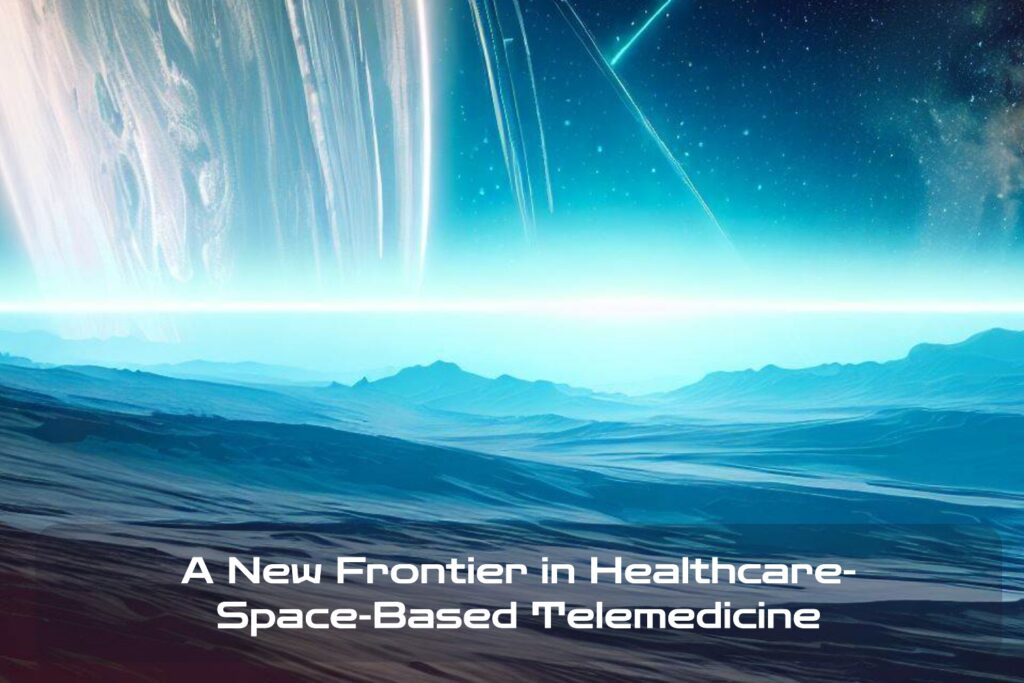The Potential of Space-Based Telemedicine and Remote Healthcare to Address Global Health and Environmental Challenges
A New Frontier in Healthcare
Space exploration has long been associated with scientific breakthroughs, technological advancements, and a sense of wonder. However, space-based telemedicine and remote healthcare are two new areas that have the potential to revolutionize healthcare as we know it.
These fields enable healthcare professionals to provide medical care from afar using technology such as satellites, video conferencing, and remote monitoring devices. The possibilities for global health and environmental impact are immense.
The Importance of Addressing Global Health and Environmental Challenges
The world faces a number of pressing issues when it comes to health and the environment. From pandemics like COVID-19 to pollution-induced climate change, the stakes have never been higher. According to the World Health Organization (WHO), at least half of the world’s population still lacks access to essential healthcare services.
Meanwhile, climate change is causing rising sea levels, natural disasters, food insecurity, and widespread animal extinctions. Addressing these challenges requires innovative solutions that can scale globally.
This is where space-based telemedicine and remote healthcare come in – by leveraging satellite technology, we can improve access to medical care while reducing the carbon footprint associated with transportation. This approach could also help monitor environmental factors such as air quality or temperature changes that can have a significant impact on human health.
Global Impact: Reducing Disparities in Access
One of the most significant impacts that space-based telemedicine can have is reducing disparities in access to healthcare between developed nations and developing nations, or rural areas versus urban areas within one country itself. In many developing countries or rural areas within developed ones, there aren’t enough doctors or clinics for everyone who needs them. This lack of accessibility often leads people to not receive timely medical attention, which leads to worsening conditions that ultimately result in death.
Space-based telemedicine can connect patients with remote healthcare professionals, many of whom are specialists able to diagnose and treat illnesses they may not have encountered before. This can help reduce disparities and make sure that everyone has access to the care they need, regardless of where they live in the world.
What is Space-Based Telemedicine?

Space-based telemedicine refers to the use of space technology to provide medical care and health-related services from a distance. This approach combines telecommunications technologies with satellite connectivity to enable
- remote consultations,
- diagnoses,
- treatments,
- and monitoring of patients.
Space-based telemedicine is often used in situations where traditional healthcare delivery methods are not feasible or where there are logistical challenges.
One example of space-based telemedicine is the use of video conferencing technology to connect doctors and patients who are geographically distant from each other. In this scenario, doctors can consult with patients in real-time, ask questions about their symptoms and medical history, and provide advice on how to manage their health.
Another example is the use of remote patient monitoring systems that can track vital signs such as
- heart rate,
- blood pressure,
- and oxygen levels
from a distance. These devices transmit data wirelessly to healthcare providers who can monitor patients’ conditions remotely.
Examples of How It Has Been Used in the Past
Space-based telemedicine has been used successfully in a variety of settings around the world. One notable example comes from NASA’s Human Research Program, which uses space-based telemedicine to monitor astronauts’ physical and mental health during long-duration missions aboard the International Space Station (ISS). The program allows for real-time communication between astronauts and medical professionals on Earth who can provide assistance or advice as needed.
Another example comes from rural areas, where access to healthcare facilities may be limited. In some cases, mobile clinics equipped with space-based telemedicine technologies have been deployed to bring medical care directly to these communities.
Patients can receive consultations with specialists located elsewhere or undergo remote diagnostic tests without needing to travel long distances.
Emergency response teams have also utilized space-based telemedicine capabilities during natural disasters or other crises when traditional infrastructure may be damaged or unavailable.
For instance, satellite phones and portable solar-powered generators have been deployed to provide communications and power in remote or inaccessible areas. These tools can provide vital links between medical personnel and those in need of assistance, potentially saving lives in the process.
Overall, space-based telemedicine represents a promising approach to addressing some of the world’s most pressing health and environmental challenges. By leveraging technological innovations and satellite connectivity, it is possible to improve access to healthcare services, reduce carbon emissions from transportation, and better monitor environmental factors that impact public health.
The Potential Benefits of Space-Based Telemedicine for Global Health and Environmental Challenges
Improved Access to Healthcare in Remote Areas

One of the biggest advantages of space-based telemedicine is its potential to improve access to healthcare in remote areas. In many parts of the world, people do not have access to basic medical care because they live too far away from hospitals or clinics.
This is especially true in developing countries, where infrastructure can be lacking. Space-based telemedicine can bridge this gap by allowing doctors and other medical professionals to provide
- remote consultations,
- diagnose illnesses,
- and even guide surgeries from a distance.
Increased Efficiency in Emergency Response Situations
Another promising application for space-based telemedicine is in emergency response situations. When disasters strike or accidents happen, getting medical help quickly can be a matter of life or death.
However, emergency responders may not always be able to get to the scene quickly enough or have the necessary equipment on hand. With space-based telemedicine, medical professionals can provide real-time support and guidance from anywhere in the world, which can save lives and reduce the risk of long-term health complications.
Reduced Carbon Emissions from Transportation
Transportation is a major contributor to carbon emissions, which are harmful to both human health and the environment. A benefit of space-based telemedicine is that it could reduce the need for patients and medical professionals to travel long distances for appointments or consultations. This would not only save time and money, but also reduce carbon emissions by eliminating unnecessary travel.
Better Monitoring and Management of Environmental Factors
Space-based telemedicine could also play a role in better monitoring and managing environmental factors that impact human health.
Satellites could be used to track air quality levels around factories or power plants that emit harmful pollutants into the atmosphere. This information could then be used by medical professionals to identify patterns of illness or disease in nearby communities and take steps to mitigate their exposure to harmful environmental factors.
Space-based telemedicine has the potential to bring about many benefits for global health and environmental challenges. By improving access to healthcare in remote areas, increasing efficiency in emergency response situations, reducing carbon emissions from transportation, and better monitoring and managing environmental factors that impact human health, it offers a promising solution for some of the world’s most pressing issues.
Challenges to Implementing Space-Based Telemedicine
Technological Limitations: The Need for Advanced Technology in Space-based Telemedicine

One of the biggest challenges to space-based telemedicine is its technological limitations. The technology required for remote healthcare delivery, data transfer, and communication is complex and expensive. The systems used must be highly reliable and able to function in extreme environments, such as outer space or polar regions.
This calls for advanced technology that can handle complex tasks and robust communication networks that can transmit large amounts of data with minimum latency. Another issue is the need for specialized equipment that can operate under different gravity conditions.
For instance, certain medical devices cannot function properly in zero-gravity conditions due to changes in how blood is distributed throughout the body. Additionally, some equipment may face problems related to radiation exposure or other environmental factors present in space.
Regulatory Hurdles: Navigating Regulations and Standards
Implementing space-based telemedicine requires meeting safety standards set by regulatory bodies such as the Federal Aviation Administration (FAA) or the Federal Communications Commission (FCC). Regulatory compliance adds significant costs as it calls for additional testing and certification processes.
Another challenge associated with regulatory compliance involves navigating privacy regulations such as HIPAA when transmitting patient information over long distances or across borders. There are also legal issues related to licensing physicians across different regions and countries, which may require extensive legal frameworks to be put into place.
Cost Barriers: Funding Challenges Associated with Space-based Telemedicine
The cost of implementing a full-fledged satellite system capable of supporting telemedicine operations can run into millions, if not billions, of dollars. This includes not only hardware costs but also expenses associated with launching satellites into orbit, ground infrastructure development/ maintenance costs, etc. Another challenge associated with funding space-based telemedicine projects involves convincing potential investors that it is worth the investment.
Given the cost of implementation, it may be difficult to find investors willing to fund such projects. Additionally, market competition can add to the difficulty of securing funding as other innovative healthcare technologies are also competing for investment.
Overall, while space-based telemedicine holds great potential for improving healthcare access and addressing global health and environmental challenges, it is not without its challenges. Addressing these challenges will require a global effort from regulatory bodies, governments, private corporations, and expert professionals in the field to develop robust technology solutions that can overcome technical limitations while meeting regulatory requirements at an affordable cost.
Case Studies: Successful Implementation of Space-Based Telemedicine
Telemedicine in Antarctica: A Lifeline for Researchers and Visitors
Antarctica is one of the most remote locations on the planet, with harsh weather conditions and limited infrastructure. Despite these challenges, scientists and researchers from around the world flock to this icy continent to study its unique environment. However, medical emergencies can arise at any time in this isolated location, making it crucial to have access to healthcare services.
In recent years, space-based telemedicine has emerged as a lifeline for researchers and visitors in Antarctica. The Australian Antarctic Division (AAD) has been using telemedicine technology to provide medical consultations and emergency assistance to those stationed on the continent.
Using satellite links, doctors in Australia can remotely examine patients and provide diagnoses and treatment options. This technology has saved countless lives in situations where traditional medical assistance would not have been possible.
Remote Healthcare Delivery in Rural Australia: Improving Access to Quality Care
Australia is a large country with vast stretches of rural areas that are often underserved by healthcare facilities. In these regions, space-based telemedicine has proven to be an effective tool for delivering quality healthcare services. The Royal Flying Doctor Service (RFDS), an Australian non-profit organization that provides medical care to remote areas via airplane or helicopter, has been using telemedicine technology since 2001.
The organization’s planes are equipped with satellite communication systems that allow doctors on board to consult with specialists located elsewhere in real-time. Through this system, patients in rural areas can receive consultations from specialists without having to travel long distances.
This not only improves access but also saves time and resources. Additionally, remote monitoring of chronic diseases such as diabetes is made possible through this technology.
Monitoring Air Pollution from Space: Understanding Environmental Factors
Air pollution is a major challenge facing many cities around the world, with serious health and environmental consequences. Traditional methods of monitoring air pollution involve ground-based sensors that can be costly and difficult to maintain. Space-based telemedicine offers a solution to this challenge by allowing for remote monitoring of air pollution from satellites orbiting the Earth.
The European Space Agency’s Sentinel-5 Precursor satellite, for example, is equipped with sensors that can detect pollutants such as nitrogen dioxide and carbon monoxide in the atmosphere. This data is then used by scientists and policymakers to develop strategies for reducing air pollution levels.
Aside from monitoring air pollution, space-based technology has been used to study other environmental factors such as deforestation, water quality, and climate change. These applications highlight the vast potential of space-based telemedicine in addressing global health and environmental challenges.
Future Possibilities for Space-Based Telemedicine and Remote Healthcare
Advancements in Technology: A Promising Path Forward

As technology continues to advance at a rapid pace, so too does the potential for space-based telemedicine and remote healthcare. One exciting development is the rise of artificial intelligence (AI) in healthcare. With AI, we could see more accurate diagnoses and more personalized treatment plans for patients.
Additionally, wearable technology is becoming more advanced, allowing for real-time monitoring of patients’ vital signs from anywhere in the world. Another interesting area of development is 3D printing technology.
In the future, it may be possible to print medical supplies and equipment on-demand in remote areas where they are needed most. Improvements in satellite communication systems will make it easier to transfer data securely and quickly between healthcare providers and patients.
Expansion into New Areas: Disaster Relief Efforts
One area where space-based telemedicine and remote healthcare could have a huge impact is disaster relief efforts. When disaster strikes, medical resources are often stretched thin, making it difficult to provide adequate care to all those who need it.
However, with space-based telemedicine solutions, doctors could remotely diagnose and treat patients affected by natural disasters or other emergencies. For example, during Hurricane Maria in Puerto Rico in 2017, American company Project HOPE deployed a team of medical volunteers equipped with satellite phones to provide remote consultations with doctors back on the mainland US.
The ability to connect with highly-trained doctors remotely proved crucial when local hospitals were destroyed or inaccessible. With continued investment into space-based telemedicine technology specifically designed for use during disaster relief efforts like this one from Project HOPE’s work following Hurricane Maria will become widely available worldwide.
The Future of Space-Based Telemedicine
Advancements within space-based telemedicine are constantly pushing its potential even further, and if we continue to invest in research and development, the possibilities are endless. We may see a future in which healthcare providers can remotely monitor patients’ health and deliver care from space, or better yet, make it possible for people living in remote areas to have access to high-quality healthcare without needing to travel hours or even days for medical attention.
Space-based telemedicine has the potential to revolutionize global health and environmental challenges by making healthcare more accessible, efficient, and effective. As we continue to face new challenges globally with the ongoing pandemic crisis, natural disasters, climate change impacts, pandemics, etc., it is clear that space-based telemedicine technology will play an increasingly crucial role in keeping people healthy and safe.
Final Thoughts
It is clear that space-based telemedicine and remote healthcare hold great promise for addressing global health and environmental issues. However, realizing this potential will require significant investment and support from governments as well as private industry.
In order to overcome the technological limitations currently facing this field of study as well as address regulatory hurdles, it is imperative that institutions come together in a unified effort. Increased funding opportunities will be necessary to encourage ongoing research into space-based telemedicine applications within various fields, such as disaster relief efforts or air pollution monitoring systems.
The integration of satellite communication systems with ground-based health facilities can revolutionize public health care systems across the world by improving access to medical knowledge sharing between regions or under-resourced areas that often face difficulty accessing such resources. Expanding public-private partnerships will be crucial to progressing forward with more ambitious projects while making them commercially viable. Overall, there is a lot of work yet to be done, but by committing support to innovative causes such as space-based telemedicine, we can ensure a healthier future that is both beneficial to people and the planet.
FAQs: Space-Based Telemedicine
1. What is Space-Based Telemedicine?
– Space-Based Telemedicine refers to the use of satellite technology and communication systems to provide medical services remotely. It allows healthcare professionals to diagnose, treat, and monitor patients who are located in remote areas or in situations where traditional healthcare access is limited.
2. How can Space-Based Telemedicine revolutionize global health and environmental solutions?
– Space-Based Telemedicine has the potential to revolutionize global health and environmental solutions by improving access to healthcare in remote areas, increasing efficiency in emergency response situations, reducing carbon emissions from transportation, and enabling better monitoring and management of environmental factors.
3. What are the benefits of Space-Based Telemedicine for global health and environmental challenges?
– Space-Based Telemedicine offers several benefits for addressing global health and environmental challenges. These include improved access to healthcare in remote areas, increased efficiency in emergency response situations, reduced carbon emissions from transportation, and better monitoring and management of environmental factors.
4. What are the challenges to implementing Space-Based Telemedicine?
– Implementing Space-Based Telemedicine faces several challenges, including technological limitations that require advanced technology in space-based telemedicine, regulatory hurdles in navigating regulations and standards, and cost barriers associated with funding challenges.
5. Can you provide examples of successful implementation of Space-Based Telemedicine?
– Yes, there have been successful case studies of Space-Based Telemedicine. For instance, telemedicine has been used in Antarctica to provide medical support for researchers and visitors in remote locations. Remote healthcare delivery in rural Australia has also improved access to quality care. Additionally, space-based technology has been used to monitor air pollution and understand environmental factors.
TL;DR…
– 💡 Space-Based Telemedicine and remote healthcare can address global health and environmental challenges.
– 🏥 Improved access to healthcare in remote areas is one of the potential benefits.
– 🚑 Space-Based Telemedicine can increase efficiency in emergency response situations.
– 🌍 It has the potential to reduce carbon emissions from transportation.
– 🌱 Better monitoring and management of environmental factors can be achieved through Space-Based Telemedicine.
– 🚀 Implementing Space-Based Telemedicine faces challenges such as technological limitations, regulatory hurdles, and cost barriers.
– 📚 Successful case studies include telemedicine in Antarctica, remote healthcare delivery in rural Australia, and monitoring air pollution from space.
– 🔮 The future possibilities for Space-Based Telemedicine include advancements in technology and expansion into new areas like disaster relief efforts.
– 🌟 The future of Space-Based Telemedicine holds great potential in revolutionizing global health and environmental solutions.

C M, a seasoned editor, journalist, and consultant, is deeply fascinated by the convergence of technology, space, and the future of humanity.
With a particular interest in transhumanity, futurology, and the philosophical and ethical dimensions of these domains, C M serves as the lead contributor to SpaceSpotlight and TranscendSphere.
When not penning insightful articles on these rapidly evolving fields, C M indulges in their love for podcasts and books, proudly embracing their status as a ‘Happy Nerd Extraordinaire!’



